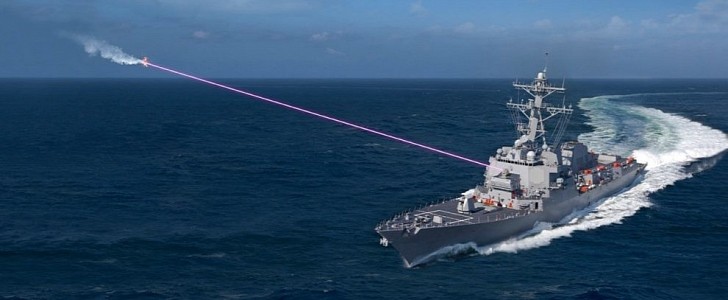The US Navy entered the Star Wars age with the first laser weapon system delivered to one of its vessels. Lockheed Martin is the laser manufacturer, but the name of the newly armed warship is not disclosed at this time.
After three-and-a-half years since being awarded the $150 million contract, Lockheed Martin put the anti-missile laser in the hands of the Navy, according to a recent press release. Allusively named HELIOS (after the Greek god of the Sun), the weapon can engage and annihilate small weapons systems.
Rockets, artillery shells, attack boats, light ground vehicles, and unmanned aerial systems are all in the crosshairs of this compact and powerful 60+ kW-class laser. The effective range of the laser is claimed at around one mile (1.6 km), given the size and power-generating predicaments to be considered.
Lockheed Martin officials say that, with future technological developments in the field of fiber lasers, the effectiveness of the weapons will increase significantly, both in range and target take-down abilities. For now, the laser weapons can multiply the firepower of traditional “kinetic energy systems” already used across the defense field.
Although it cannot (yet!) sink ships, or down fighter jets, the “directed energy” weapon is mathematically precise. “Our beam control technology enables precision equivalent to shooting a beach ball off the top of the Empire State Building from the San Francisco Bay Bridge.”
Also, the HELIOS can scramble enemy Intelligence, Search, and Reconnaissance systems fitted on unmanned aerial systems (such as drones or missiles). The mythologically-acronymic High Energy Laser with Integrated Optical-dazzler and Surveillance (HELIOS) is also scalable. That means it will, at some point, serve as an upgrading platform for developing warfare lasers.
So, the US Navy officially got its first laser, one of the first two in the contract, which also contains almost one billion dollars worth of options for Lockheed Martin.
Rockets, artillery shells, attack boats, light ground vehicles, and unmanned aerial systems are all in the crosshairs of this compact and powerful 60+ kW-class laser. The effective range of the laser is claimed at around one mile (1.6 km), given the size and power-generating predicaments to be considered.
Lockheed Martin officials say that, with future technological developments in the field of fiber lasers, the effectiveness of the weapons will increase significantly, both in range and target take-down abilities. For now, the laser weapons can multiply the firepower of traditional “kinetic energy systems” already used across the defense field.
Although it cannot (yet!) sink ships, or down fighter jets, the “directed energy” weapon is mathematically precise. “Our beam control technology enables precision equivalent to shooting a beach ball off the top of the Empire State Building from the San Francisco Bay Bridge.”
Also, the HELIOS can scramble enemy Intelligence, Search, and Reconnaissance systems fitted on unmanned aerial systems (such as drones or missiles). The mythologically-acronymic High Energy Laser with Integrated Optical-dazzler and Surveillance (HELIOS) is also scalable. That means it will, at some point, serve as an upgrading platform for developing warfare lasers.
So, the US Navy officially got its first laser, one of the first two in the contract, which also contains almost one billion dollars worth of options for Lockheed Martin.










